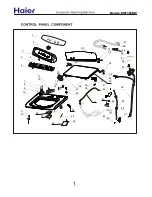
5
WASHER CARE
Cleaning Your Washer
Use a soft, damp cloth or sponge to wipe up any spills such as
detergent or bleach from the outside of your washer.
Clean your washer interior by mixing 1 cup (250 mL) of chlorine
bleach and 2 cups (500 mL) of detergent. Pour this mixture into
your washer and run it through a complete cycle using hot water.
Repeat this process if necessary.
Remove any hard water deposits using only cleaners labeled as
washer safe.
Cleaning the liquid fabric softener dispenser (on some
models):
1. Remove dispenser by grasping top with both hands and
squeezing, while pushing upward with thumbs.
2. Rinse dispenser under warm water, then replace it.
NOTE: Some models are equipped with a liquid fabric softener
dispenser. To avoid damage to the washer or clothing, do not
wash clothes with the liquid fabric softener dispenser removed or
add detergent or bleach to this dispenser; it is for liquid fabric
softener only.
Water Inlet Hoses
Replace inlet hoses after 5 years of use to reduce the risk of hose
failure. Periodically inspect and replace inlet hoses if bulges,
kinks, cuts, wear or leaks are found.
When replacing your inlet hoses, mark the date of replacement
on the label with a permanent marker.
Moving and Storage
Because some water may stay in the hoses, freezing can damage
your washer. If storing or moving your washer during freezing
weather, winterize it.
Winterizing your washer
1. Shut off both water faucets. Disconnect and drain water inlet
hoses. Pour 1 qt (1 L) of R.V.-type antifreeze into the basket.
2. Run washer on a drain and spin setting for about 30 seconds
to mix the antifreeze and remaining water.
3. Unplug washer or disconnect power.
To use washer again
1. Flush water pipes and hoses. Reconnect water inlet hoses.
Turn on both water faucets.
2. Plug in washer or reconnect power.
3. Run the washer through a complete cycle with 1 cup (250 mL)
of detergent to clean out antifreeze.
Storage, non-use or vacation care
Operate your washer only when you are at home. If you will be on
vacation or not using your washer for an extended period of time,
you should:
1. Unplug washer or disconnect power.
2. Turn off the water supply to the washer. This helps avoid
flooding (due to a water pressure surge) while you are away.
Electrical Shock Hazard
Plug into a grounded 3 prong outlet.
Do not remove ground prong.
Do not use an adapter.
Do not use an extension cord.
Failure to follow these instructions can result in death,
fire, or electrical shock.
WARNING


























